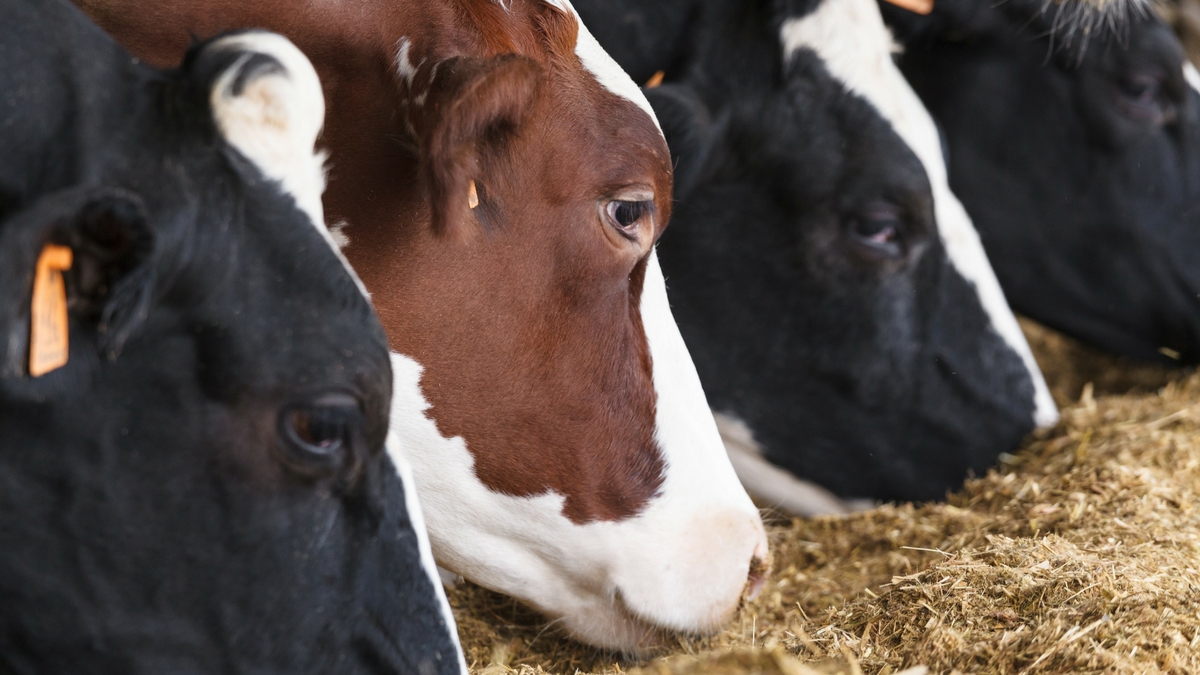The following is an edited transcript of Tom Martin’s interview with Dr. Kristen Brennan, a research project manager at the Alltech Center for Animal Nutrigenomics and Applied Animal Nutrition in Nicholasville, Kentucky.
Click below to listen to the podcast:
Dr. Kristen Brennan is a research project manager at the Alltech Center for Animal Nutrigenomics and Applied Animal Nutrition in Nicholasville, Kentucky. In this interview with Tom Martin, Brennan helps us gain a better understanding of her field, nutrigenomics, and its role in sustainable agriculture.
Tom: What is the science of nutrigenomics?
Kristen: The easiest way to think about nutrigenomics is to break the word down into what it is: “nutri" and “genomics.” What we're aiming to study with nutrigenomics is how nutrition — whether that’s nutrients, forms of nutrients, diets, timing of diets — influences the animal's genome. So, we’re not changing the genome, but influencing the activity of all the genes of that animal’s genome.
Tom: Is this an outgrowth of the human genome project, or has it been around a lot longer than that?
Kristen: Nutrigenomics is something that's been around forever. From the time the first living organism evolved, it needed nutrients, and those nutrients had influence on the activity of the genes within that animal or cell. The thing that we've done within the last several years is to figure out how to capture that information. It's always been there, we just never had a way of measuring it before. Technologies like genome sequencing are the core foundation for measuring what we're seeing.
Tom: Is there a point in time when we realized that nutrients were having an impact on genetic expression?
Kristen: I think we’ve known for a long time the importance of nutrition. Centuries and centuries ago, they had an idea that nutrition had a vital role. I don't know if we knew at that point, really, what DNA was and what genes did, but we knew that nutrition could influence the outcome, or a phenotype of an animal — what we're seeing on the outside — and how important it was for good health.
Tom: What are the advantages of nutrigenomics in animal studies?
Kristen: What I think makes this field so exciting is that, first of all, when we’re dealing with actual sampling, we need a very small sample amount. We can do this with, for instance, a small draw of blood from an animal, or we can take a small biopsy. So, you're not having to euthanize an animal to get tissue.
Even more of an advantage is the amount of information we get. If you think about most genomes, you're talking about thousands of genes. We can measure in a single snapshot how every one of those genes is behaving in response to a diet or nutrition. That is an amazing amount of information.
The other advantage is that it can be really rapid. From the time we get a sample to the time we have an output of data, it can be as short as just a few days in the lab. So, a lot of information, small input and a ton (of data) in a very rapid way.
Tom: And are you able to understand why some animals respond differently than others to the very same nutrients?
Kristen: Yes. We can use this information to understand that. An example would be healthy versus diseased animals and why nutrition may play a role in how they respond to that illness. More and more, we're starting to understand how differences on a genetic level — different breeds of animals, different production states, things like that — can influence how that animal responds.
Tom: Are you able to dig down into it and figure out how nutrients and bioactive components in the food turn on or turn off certain genes?
Kristen: Yes. The biggest amount of information we get is just a simple “Do they or do they not turn genes on or off?” So, how does each individual gene activity respond to what you're feeding? As we’re understanding that more and more, we can take a step back and start to understand how they're doing it. They are what we call signaling pathways, which are like, if you set up a row of dominoes and you hit the first one, it sets everything off. It’s the same thing with gene activity. There is a series of molecules that are responsible for regulating or activating other ones. And we can start to decipher how we get from the nutrient that we’re feeding or the diet we're feeding to that endpoint, that last domino in the line.
Tom: You can actually target issues that call for some kind of nutritional intervention?
Kristen: Yes. And that's obviously one of the most exciting applications of this research. We can use this to define precision nutrition.
One of the challenges with feeding animals, or people in general, is that there are so many environmental factors that influence how an animal responds to diet — things like illness and disease, but also production state, where they're living, what their basal diets are. And so, we can use this technology to get precise information on how we can use nutrition to get the best performance or best health out of that animal.
Tom: How do you carry out your research? What goes on in Kristen Brennan’s laboratory?
Kristen: It’s magic! This research is done in several steps. It’s really a team effort. The simplest study we have is between two groups of animals, and because so many things could influence gene expression, we want to make sure that those two groups of animals are as identical as possible — same breed, sex, age, production state, and they’re housed in similar environments. The only thing we want different between those two groups is the nutrient we’re interested in.
For instance, if we’re looking at a form of a mineral like selenium, we might have one diet that contains selenium in the form of sodium selenite, and we might have the exact same diet for the other group that has selenium in the form of organic selenium like our Sel-Plex® product. Once we have fed these diets for a given amount of time — it just depends on what we're interested in looking at, what tissues and what nutrients we’re evaluating — then we obtain a sample. It can be as simple as just a very tiny muscle biopsy or a few milliliters of blood. We bring that to the lab, and our laboratory technicians will essentially take that tissue, rupture the cellular membranes and then the nuclear membranes and purify what we call the mRNA, or the transcripts, that are located within the nucleus. We make sure that transcript, or a total RNA, is of super high quality and purity because these assays are so precise. We have high standards for what we can use.
And then we use a commercially available DNA microarray. And what that allows us to do is profile. It has probes for each gene on the animal's genome — for example in the case of a chicken, it has something like 18,000 probes — and that allows us to measure whether the mRNA, or the transcript, for each of those genes has been increased or decreased in response to the nutrient that we fed.
At the end, we get a long spreadsheet that says gene A is increased, gene B unchanged, gene C is decreased.
Then the tough part comes, and that is the data analysis. So, we have all of these data points — you’re talking about thousands — and it is sort of like taking one of those huge puzzles. If you took that box of puzzle pieces and threw it on the ground, you would just have a giant mess, right? When I get that Excel spreadsheet of thousands of rows and columns, that’s what it’s like, essentially. So, we need help to try to piece those puzzle pieces together. If we took one piece out, we might find a corner and that's really important. Just like if I look at that spreadsheet, I might find a gene that's very important, that's very highly increased or decreased. That's a starting point.
What we really need to do to see the big picture is piece those puzzle pieces together. We use what we call bioinformatics — essentially biological statistics — and we use software programs that say, okay, these 100 genes are related, they all have a common biological function, and based on their activity, we predict that biological function to increase or decrease. And that helps us make sense of this information.
So, just like piecing those puzzle pieces together, we get that big picture of what's going on inside an animal that results in what we're seeing on the outside like improved growth, or improved feed efficiency, or improved markers of health.
Tom: I'm under the impression that the “Holy Grail” for you would be to find and establish a link between nutritional genomics approaches and applied nutritional research. Can you explain?
Kristen: Sure. The ultimate goal, at least in my view, for nutrigenomics is when we do traditional nutrition studies, we take an experimental diet, we feed it to an animal and we look at a phenotypic output. So, what do we see in the whole animal? That might be body weight change, growth rates, feed efficiency — things we can measure in the whole cow or by just looking at the animal. We might look at blood markers, stuff like that. What often is lacking and what we can use nutrigenomics for is, how do we get from point A to point B? How do we get from feeding this diet to the response in the whole animal?
What nutrigenomics gives us is a tool to look at a molecular reason for those changes. We can use nutrigenomics to figure out, are we affecting energy expenditure in the cell? Are we affecting protein translation in the muscle? Things like this can help us explain what we're seeing in that animal instead of just guessing on how something works.
Tom: Does this technology, nutrigenomics, reduce our reliance on large-scale animal studies, and is it less invasive than the traditional approach?
Kristen: I think so. When we do these studies, we can work with a much smaller number (of animals) per treatment. So, where you might need hundreds of animals to get, say, carcass quality measurements that are significant, we can use six or 10 animals per treatment and still get some of the same information that would explain why we see changes in a large animal. Obviously, they're complementary, but we use this technology to minimize the number of animals we need per treatment.
The other advantage is the obtaining of samples. We don't need a whole kilo of skeletal muscle to do our analysis. We need a tiny amount. So, that really is noninvasive. We can use a simple blood draw that is noninvasive and get this information out of that.
Tom: The 21st century farm is a changed place compared with that of the previous century. A big reason for that is the arrival of a lot of science, technology and big data. If we were to take your science, nutrigenomics, out of the laboratory and into the farm, how would producers use what you've learned?
Kristen: I think one of the major ways they can use it is precision nutrition — really formulating diets to meet the actual needs of an animal. And also to understand the form versus function of different nutrients. So, how do we get the best that we can get out of an animal through nutrition? Nutrigenomics gives us that tool to understand how.
Tom: To carry that further, beyond helping to determine what will work for an animal's genetic type, is nutrigenomics helping explain why we need to find what works for a given animal?
Kristen: Absolutely. And I think it really helps push the idea of precision behind nutrition. For so long, we've overfed nutrients. We haven't really paid attention to form versus function. Nutrigenomics is giving us reasons why form is so important in nutrients, and why precise levels are important. We're taking the guessing game out of animal nutrition.
I think as our population grows and the need for food continues to increase, that really optimizing nutrition based on an animal’s genetic potential is going to be really, really important.
Tom: How can this genomic information help us better understand nutrition and nutrient science?
Kristen: That’s a great question. This gives us a good understanding of the hidden effects of nutrition — the things that we don't really understand; why we see the changes. Why are we seeing increased energy efficiency with different forms of selenium, for instance? If we just look at our traditional nutrition research, we have no idea. But we use nutrigenomics to say, “Okay, well, the genes that control, say, mitochondrial growth in the skeletal muscle in the animals are turned on by Sel-Plex, and that explains why we see changes in energy expenditure.”
That’s the type of stuff that we can get through traditional animal nutrition research, and nutrigenomics really helps push that information ahead and gives us a better understanding of how nutrients function — things that we can't see by just looking at an animal.
Tom: One final question: Among the things that you're working on right now, what really interests you and excites you?
Kristen: Everything, as a true scientist! One of the areas that I'm completely fascinated by, and have been for years — and we've done quite a bit of work on it, but it's just something that I start to think about and almost gives me a headache — is the idea of nutritional programming. This is the concept of how early life nutrition — whether that's in a neonatal animal or even in the gestating diet, looking at offspring — how nutrition early in life influences an animal throughout its lifespan.
We've done a lot of work to look at some of the things that happen, like gene expression changes that occur. When we change the diet of an animal in the first 96 hours of life, those patterns and the changes stay with that animal throughout its lifespan, and that completely fascinates me.
I think that's an application that is something that can be applied through all different species of animals, whether that’s livestock or even humans. We think about how you are what you eat, but you're also what your mother ate and what her mother ate and then maybe what her dad ate. It starts to really fascinate you. So, that’s probably one the most exciting areas that we work on.
Tom: Dr. Kristen Brennan is a research project manager at the Alltech Center for Animal Nutrigenomics and Applied Animal Nutrition in Nicholasville, Kentucky. Thank you for joining us.
Kristen: Thank you.
Looking for more information on the science and business of agriculture? Click here.























